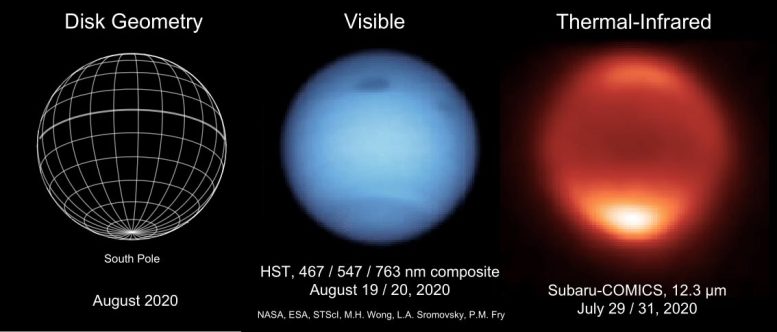Observed changes in Neptune’s thermal-infrared brightness, a measure of temperature in Neptune’s atmosphere. The plot shows the relative change in the thermal-infrared brightness from Neptune’s stratosphere with time for all existing images taken by ground-based telescopes. Brighter images are interpreted as warmer. Corresponding thermal-infrared images (top) at wavelengths of ~12 µm show Neptune’s appearance in 2006, 2009, 2018 (observed by the European Southern Observatory’s Very Large Telescope’s VISIR instrument), and 2020 (observed by Subaru’s COMICS instrument). The south pole appears to have become dramatically warmer in just the past few years. Credit: Michael Roman/NASA/JPL/Voyager-ISS/Justin Cowart
Neptune Is Cooler Than We Thought
New research led by space scientists at the University of Leicester has revealed how temperatures in
Neptune as seen in visible light (centre) and thermal-infrared wavelengths (right), in 2020. The centre image combines multiple images from the Hubble Space Telescope, while the thermal-infrared image on the right was taken from the Subaru Telescope on Maunakea, Hawai’i. In the thermal-infrared, Neptune’s warm south pole glows more brightly than ever seen before. Credit: Michael Roman/NASA/ESA/STSci/M.H. Wong/L.A. Sromovsky/P.M. Fry
By analyzing the data, the researchers were able to reveal a more complete picture of trends in Neptune’s temperatures than ever before.
But to the researchers’ surprise, these collective datasets show a decline in Neptune’s thermal brightness since reliable thermal imaging began in 2003, indicating that globally-averaged temperatures in Neptune’s stratosphere – the layer of the atmosphere just above its active weather layer – have dropped by roughly 8 degrees
Voyager 2 view of Neptune, captured in August 1989. Credit: NASA/JPL-Caltech/Kevin M. Gill

